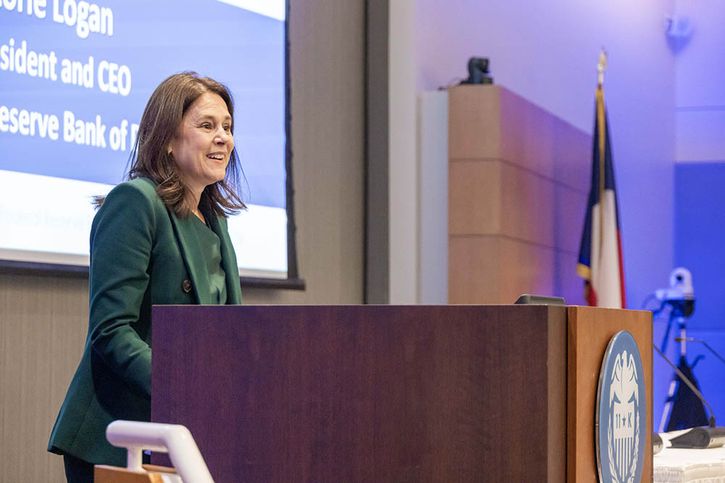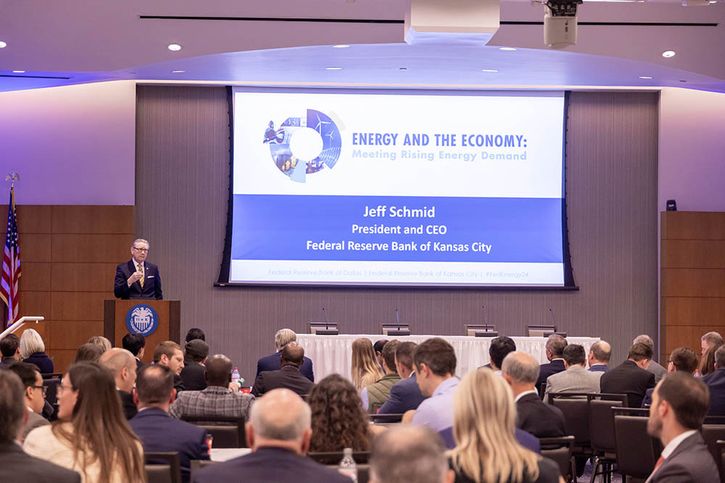Energy powers almost every aspect of our lives. It drives industries, transportation, communication, technology and economic development. To highlight its crucial role, the Dallas and Kansas City Federal Reserve Banks in November hosted the ninth joint Energy and the Economy conference.
More than 200 participants attended the conference in Dallas, with an additional 750 watching virtually. The 2024 theme was “Meeting the Rising Energy Demand.”
“Participants at this year’s energy conference joined in meaningful discussions about the challenges facing the power sector, ranging from geopolitical developments that have become increasingly impactful to the energy sector, to the future demand for oil and the opportunities and challenges for renewable power and additional sources of energy,” said Chad Wilkerson, senior vice president, Oklahoma City Branch executive and session moderator during the conference.
The conference agenda was divided into four parts, with various topics and speakers in each session. Dallas Fed President Lorie Logan opened the conference by talking about energy, as well as providing an economic outlook.
“Both the Dallas and Kansas City banks have invested deeply in understanding the energy economy,” Logan said. “Together, our districts empower the nation, contributing nearly 40 percent of the U.S. energy sector’s GDP. At the Dallas Fed, we’re committed to leading the energy conversation through our research at the intersection of energy and economics.”
Logan added that economic activity is strong, inflation is coming down, and the economy is approaching a point that can sustainably deliver both maximum employment and stable prices.
“I anticipate the FOMC will most likely need more rate cuts to finish the journey, but it’s difficult to be sure how many cuts may be needed and how soon they may need to happen,” Logan added. “I am keeping an open mind, scrutinizing economic data and financial conditions, and listening carefully to business and community contacts as I assess what next steps may be appropriate for monetary policy.”

“Together, our districts empower the nation, contributing nearly 40 percent of the U.S. energy sector’s GDP," Dallas Fed President Lorie Logan said during the conference. Photos courtesy of the Federal Reserve Bank of Dallas
Rapid transformation
The first session explored the global outlook for energy going forward, while the second session addressed building infrastructure needed to meet long-term demand. David Rodziewicz, senior economics specialist at the Kansas City Fed, served as a panel chair and helped plan the conference agenda. He hopes participants learn how the energy industry is rapidly transforming.
“The takeaway for me is that demand for energy is rising, putting the industry up against some constraints,” he said. “My session on infrastructure took a broad look at these issues and the challenges/opportunities associated with building new infrastructure for meeting both growing and changing energy demand. Across the board, permitting was highlighted as a critical issue for building new energy infrastructure. Additionally, capital constraints and supply chains remain further headwinds for both growing and changing energy supplies.”

In his keynote remarks, Kansas City Fed President and CEO Jeff Schmid spoke about the vital role that the energy industry plays across the Tenth District.
View from the Tenth District
The keynote speech was delivered by Kansas City Fed President Jeff Schmid. He spoke about the energy industry in the Tenth District, which includes Colorado, Kansas, western Missouri, Nebraska, northern New Mexico, Oklahoma and Wyoming.
“Like Texas, the Tenth District also outpaces the United States in renewable energy,” Schmid said. “Kansas, Nebraska, and Oklahoma are some of the windiest states in the country, and Colorado, New Mexico, and Wyoming are some of the sunniest. Pipelines and oil storage in Cushing, Oklahoma, are vital infrastructure, and many District manufacturers support oil and gas firms, as well as the renewable energy sector. Furthermore, the region’s important agricultural sector is interwoven with the energy economy, supplying feedstocks to regional biofuel plants and producing renewable ethanol and biodiesel.”
Industry perspectives
Other sessions covered how the United States will meet the rising demand for power and how companies are adapting to the ever-changing energy landscape. The conference was capped with a panel discussion among energy sector executives.
“I’ve been in the energy industry for 20 years,” said Kristina Lund, president of the Pattern Energy Group. “One of the bright sides is technology has provided us with so many different kinds of opportunities…a lot of innovation. It’s way better to have growing demand than declining demand.”
Rodziewicz said that many people ask why the Federal Reserve hosts an energy conference. He answers by explaining that the event provides a valuable way for people inside the Fed to listen, convene and connect with energy industry leaders.
“It provides an important input for calibrating our own views on the energy industry,” he added. “While we set the agenda and pick the speakers, we learn just as much from the conference as those in the audience.”
Next year’s conference will be held at the Kansas City Fed’s Denver Branch. Colorado is both a leading state in terms of oil and natural gas production, but also in renewable energy production.
Takeaways from the conference
Chad Wilkerson of the Kansas City Fed and Kunal Patel of the Dallas Fed share some of their thoughts about the themes discussed at the 2024 Energy and the Economy Conference.
Endnotes
-
1
Learn more about the annual conference and the Kansas City Fed's energy-related research and analysis.
